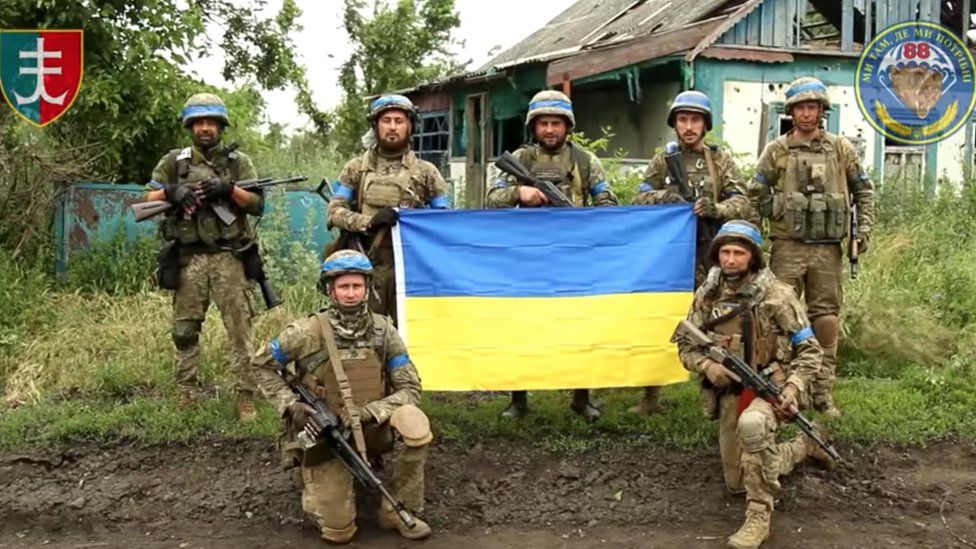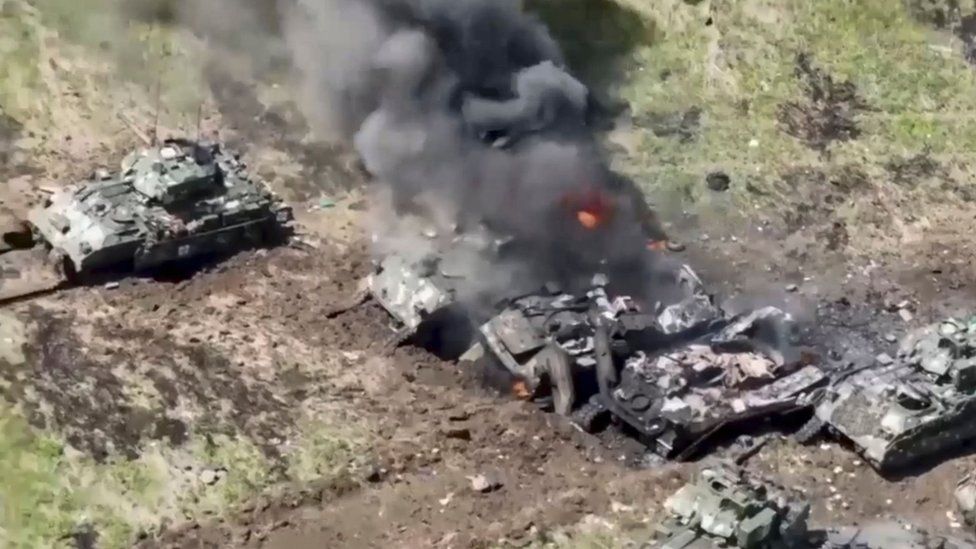Frank Gardner

"Don't call it a counter-offensive," say the Ukrainians. "This is our offensive, it's our chance to finally drive out the Russian army from our land."
All right, but what will it take to actually succeed?
First off, let's not get distracted by the recent hard-fought but tiny territorial gains Ukraine has been making as it retakes obscure, half-abandoned villages in the eastern Donetsk and south-eastern Zaporizhzhia regions.
After months of stalemate, images of victorious, battle-stained Ukrainian soldiers holding up their country's blue and yellow flag in front of a bullet-ridden building is a welcome morale boost for Ukrainians.
But in the big strategic picture, this is a sideshow.
The area of Russian-held territory that matters most in this campaign is the south: the area between the city of Zaporizhzhia and the Sea of Azov.
This is the so-called "land corridor" that connects Russia to illegally annexed Crimea, the central part of that purple-shaded strip on the map below that has barely changed since the early weeks of the invasion last year.
If Ukraine can split that in two and hold the ground it's retaken, then its offensive will have largely been successful.
It would cut off Russia's troops in the west and make it hard to resupply their garrison in Crimea.
It would not necessarily spell an end to the war - which some are now predicting could drag on for years - but it would put Ukraine in a strong bargaining position when the inevitable peace talks finally take place.

But the Russians have looked at the map, quite some time ago, and reached the same conclusion.
So while Ukraine sent its soldiers off to Nato countries for training and readied their 12 armoured brigades for this summer campaign, Moscow spent that time constructing what is now being called "the most formidable defensive fortifications in the world".
Blocking Ukraine's path to the coast - its own coast, let's not forget - are layer upon layer of Russian minefields, concrete tank-blockers (known as "dragons' teeth") bunkers, firing positions and trenches wide enough and deep enough to stop a Leopard 2 or M1 Abrams tank literally in its tracks.
All of this is covered by pre-determined artillery impact zones calibrated to rain down high explosive on Ukraine's armoured vehicles as they and their crews wait for their engineers to find a way through.
The early signs are - and it is still very early in this campaign - that those Russian defences are so far holding fast.
 IMAGE SOURCE,RUSSIAN DEFENCE MINISTRY/EPA-EFE/REX/SHUTTERSTOCKImage caption,
IMAGE SOURCE,RUSSIAN DEFENCE MINISTRY/EPA-EFE/REX/SHUTTERSTOCKImage caption,Russia's military claims that a number of Ukraine's western-supplied tanks and armoured personnel carriers have been destroyed in fierce fighting
Ukraine has yet to commit the bulk of its forces - so these are probing, reconnaissance attacks designed to reveal the whereabouts of Russia's artillery and search out areas of vulnerability in their lines.
In Ukraine's favour is morale. Its soldiers are highly-motivated and fighting to liberate their own country from an invader.
Most of Russia's troops do not share that motivation, and in many cases their training, equipment and leadership are inferior to Ukraine's.
The General Staff back in Kyiv will be hoping that if they can achieve a sufficient breakthrough then a collapse in Russian morale will be contagious, spreading across the battlefront as demoralised Russian troops lose the will to fight.
Also in Ukraine's favour is the quality of hardware that Nato countries have provided. Unlike Soviet-designed armoured vehicles, Nato's tanks and infantry fighting vehicles can often withstand a direct hit, or at least enough to protect the crew inside who then live to fight on.
But will that be enough to counter the strength of Russia's artillery and drone attacks?
Russia, as the vastly bigger country, can draw on more resources than Ukraine. President Vladimir Putin, who started this war in the first place, knows that if he can only wear down the Ukrainians into a stalemate that drags on into next year then there is a chance that the US and other allies will tire of supporting this expensive war effort and start to pressure Kyiv to reach a ceasefire compromise.
Finally, there is the matter of air cover, or lack of it. Attacking a well dug-in enemy without sufficient close air support is highly risky.
Ukraine knows this, which is why it's long been pleading with the West to supply it with F16 fighter jets.
The US, which makes them, did not give the green light for this until late May, by which time the first, preparatory, phase of Ukraine's offensive was already under way.
Media caption,
Watch: A video on social media purports to show a Ukrainian flag being raised in Neskuchne, Donetsk Oblast
Critically for Ukraine, the game-changing F16s may now arrive too late on the battlefield to play a key role in the early phases of this counter-offensive.
This is not to say the Ukrainians will lose.
Time and again they have proved themselves agile, resourceful and inventive. They successfully drove the Russian army out of Kherson by hitting their rear-area logistics hubs to the point where the Russians could no longer resupply their troops in that southern city.
Equipped with long-range weapons like Britain's Storm Shadow cruise missile, Ukraine will be attempting to do the same now.
But amidst all the claim and counter-claim of a propaganda war, it may yet be weeks or even months before we get a clearer picture of who is likely to ultimately prevail in this war.
No comments:
Post a Comment